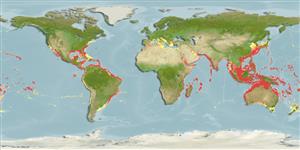Ophiuroidea |
Amphilepidida |
Ophiactidae
Environment: milieu / climate zone / depth range / distribution range
Ecology
Reef-associated; depth range 0 - 550 m (Ref. 111335), usually 1 - 100 m (Ref. 800). Tropical
Cosmopolitan.
Length at first maturity / Size / Weight / Age
Maturity: Lm ? range ? - ? cm Max length : 2.0 cm TL male/unsexed; (Ref. 415)
Minimum depth from Ref. 83942. It is found in intertidal and subtidal areas, particularly on rocky and muddy substrates (Ref. 83942). Inhabits all reef habitats; often lives in shells, gravel, sand, clay (Ref. 130839), and in sponges (Ref. 415). It occurs on mangrove swamp (Ref. 111335), dead corals with algae (Ref. 800), and seagrass Halimeda sp. (Ref. 86568). Suspension feeder (Ref. 116259). In crevices, part of fouling communities found in mariculture zones (Ref. 127121).
Life cycle and mating behavior
Maturity | Reproduction | Spawning | Eggs | Fecundity | Larvae
The mode of reproduction is asexual fissiparity.
Collin, R., M.C. Díaz, J. Norenburg, R.M. Rocha, J.A. Sánchez, M. Schulze, A. Schwartz and A. Valdés 2005 Photographic identification guide to some common marine invertebrates of Bocas Del Toro, Panama. Caribbean Journal of Science. 41(3):638-707. (Ref. 415)
IUCN Red List Status
(Ref. 130435: Version 2025-1)
CITES status (Ref. 108899)
Not Evaluated
Not Evaluated
Threat to humans
Human uses
| FishSource |
Tools
More information
Trophic EcologyFood items (preys)Diet compositionFood consumptionPredators Population dynamicsGrowthMax. ages / sizesLength-weight rel.Length-length rel.Length-frequenciesMass conversionAbundance Life cycleReproductionMaturityFecunditySpawningEggsEgg developmentLarvae PhysiologyOxygen consumption
Human RelatedStamps, coins, misc.
Internet sources
Estimates based on models
Preferred temperature
(Ref.
115969): 21.1 - 29, mean 27.2 (based on 5294 cells).
Fishing Vulnerability
Low vulnerability (10 of 100).
Price category
Unknown.
